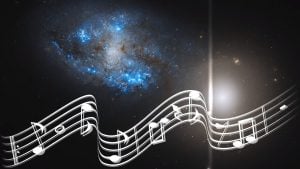

projects. In the latest sonification NASA released, we get to “hear” two galaxies as they interact. And, as always – it’s absolutely magical.
This data sonification represents Arp 140, which displays two galaxies interacting with each other. The galaxy on the left is a barred spiral galaxy identified as NGC 275, while the one on the right is a lenticular galaxy known as NGC 274. Barred spiral galaxies have a bar of stars that run through the center of their bulge, which is visible in this image as a vertical bright-white haze in NGC 275. Lenticular galaxies, on the other hand, are somewhere between an elliptical and a spiral galaxy. They receive their name from their edge-on appearance, which resembles a disk. This “disk” is primarily composed of old stars with limited gas and dust.
Credits: NASA/ESA/R. Foley (University of California – Santa Cruz)/Processing: Gladys Kober (NASA/Catholic University of America)
In this image, scientists have converted data into sound by assigning pitch to each color. The pitch is determined by the brightness of the color, where bluer light represents a higher pitch and redder light represents a lower pitch. For the resolved stars and background galaxies, the pitch is mapped to their apparent size, such that larger objects have a lower pitch and smaller objects have a higher pitch. Similarly, brighter light is represented as a louder sound throughout the image.
What is sonification?
Sonification is the transformation of data into sound, essentially making data audible. It’s like taking information and translating it into a language our ears can understand, similar to how data can be visualized through charts and graphs.
Imagine listening to the weather forecast instead of reading it. A rising pitch could indicate increasing temperature, while a rumbling sound might represent approaching rain. That’s, very simply put, what sonification does.
As for NASA, they take complex data from telescopes, probes, and other instruments. And then, they translate their images into sound, using features like colors or brightness, allowing us to “hear” the universe in a whole new way.
For more NASA sonifications, check out the links below:
[via Digital Trends]







